Sasa Lada
‘House as small as you can fit and
land as far as you can see’
Photographs and drawing from Santorini in the 60s
The exhibition presented unpublished material of architectural drawings and photographic recording of settlements and landscapes of Santorini, from the personal archive of Sasa Lada, Professor Emeritus of Architecture at the Aristotle University of Thessaloniki, who visited Santorini in the late 1960s, during her studies and captured its space in photographs and drawings. The archive consists of around 1000 photographs and drawings and a small number has been selected to be included in the exhibition.
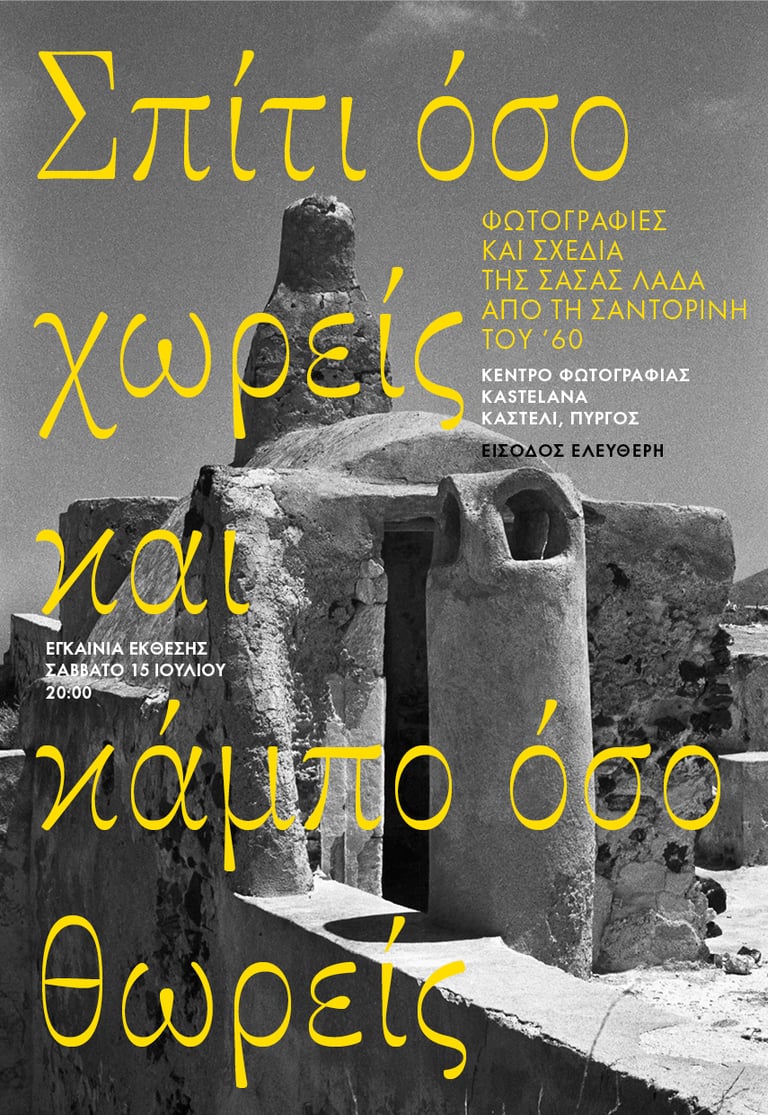

All photographs© Sasa Lada
Sasa Lada: about the exhibition:
Fernand Braudel stated in the preface to his book "Mediterranean "I loved the Mediterranean with a passion ". To paraphrase Braudel, I think the quote "I loved Santorini with a passion" has provided driving force behind the setting up of this exhibition today. I retired a few years ago and while exploring my past, I rediscovered the archive of Santorini that I had kept in the shadows for so many years. The 1968 photographs and my 1969 diploma thesis project on Fira came to light and I started looking for ways to give them (or was it to give me?) a second chance or better yet a return to their place of origin.
I would like to return the gift that Santorini gave to me in the 1960s. At that time, Santorini was barely healing the wounds of the devastating earthquake of 1956 and was preparing to open its sails to the sirens of tourism. Santorini was captivating with its explosive landscape, the dizzying descent of the caldera and its unique architecture, the strong winds, the black-red volcanic rocks and the sunken, subterranean settlements. I encountered its "anonymous architecture" - how unfair is this name for a social process where all people literally and daily construct their dwellings in an arid, windswept and unique landscape. For this reason, I prefer the concept of "vernacular architecture" which I believe best captures the phenomenon of this architecture over the words branded architecture.
The exhibition is fortunate to be hosted in an iconic three-storey building at the entrance of Kastelli in Pyrgos, a place we had walked by, photographed and recorded voraciously during our stay in Pyrgos.
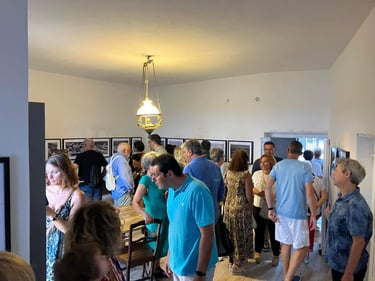
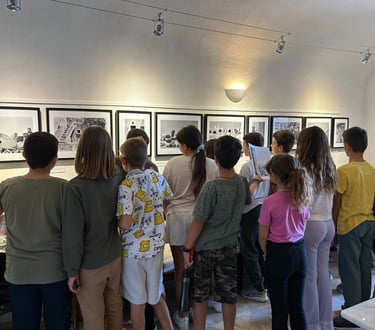
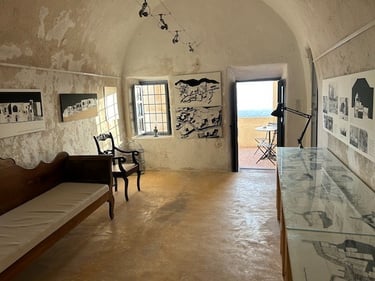


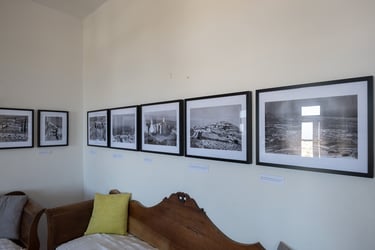







Sasa Lada is talking to ATLANTEA before the opening of the exhibition. She shares her memories from Santorini in 1968, concluding that: 'Today, many years after the end of innocence, I hope that re-claiming the quote "House as small as you can fit and land as far as you can see" in the title of this exhibition will be regarded as a tiny reminder of what we have forgotten and that we should perhaps urgently consider again, such as our critical relationship with the environment and the history of each place.


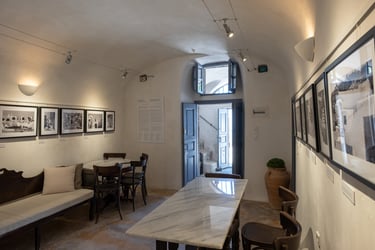


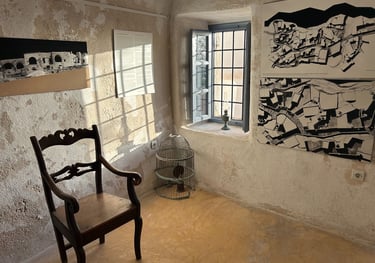
© Stergios Karavatos
© Stergios Karavatos
© Stergios Karavatos
Santorini: a place and its architecture
During the five-year long course at the School of Architecture of the Aristotle University of Thessaloniki (1964-1969), the study of vernacular architecture was the exclusive subject of the Department of Morphology-Rhythmology with Professor Nikos Moutsopoulos. A prerequisite for the successful completion of the module was the summer fireldwork on recording, i.e. the on-site study, mapping and design of vernacular architecture in selected settlements and monuments throughout the country. In my second year of studies, I became familiar with the vernacular architecture of Pylaia, the Byzantine and post-Byzantine churches in Veroia, the study of architecture in Trikeri of Magnesia. In 1968, our group studied the settlements of Akrotiri and Pyrgos in Santorini. At the end of that same year we presented our work as a public lecture, with documentation and slides of the drawings and photographs. A selected series of these drawings, area plans, floor plans, sections, elevations and perspectives are exhibited on panels on this floor.
Hand-made architecture – hand-made drawings
We were in awe of the unique architecture of Santorini and the valuable lesson of the age-old Mediterranean Architecture of economy and culture. We captured ways of life and architecture in hand-drawn drawings and negative films, drawn with graphos and zilch pens, with china and watercolor on rice paper and transparencies, driven by the fluid forms of the structures, the dominance of the all-white surfaces and the rough reddish-black stones of the volcano. We climbed up the Goula in Akrotiri and Kasteli in Pyrgos, witnessing the uninterrupted landscape. This reiterated the saying "land as far as you can see". We saw the economic and social inequalities between the inhabitants of the two settlements, differences that were reflected on the architecture of them, more primitive and of minimal size in Akrotiri, and with larger buildings, clear organization and relative comfort in Pyrgos. These findings were also described in the text of our lecture in 68,:
"..... "The form of the houses reflects the social structure and the occupation of the residents. Pyrgos is inhabited by landowners and farmers, so they have larger spaces, clear organization and relative comfort. On the contrary, in Akrotiri, a place of clingers, as the locals call it, there are many dug out buildings, with minimum space, greater freedom and illegal structures, high density, complexity." (p.15)
We went on to find that : "In Santorini, a place with unique type of soil, with a dry climate, sparse water, a place exposed to the strongest winds of the Aegean, with inhabitants who are fishermen, farmers (wine producers) and sailors, noted in their majority by their poverty, one cannot but think of an architecture that expresses a way of life connected to the house, its courtyard and the street seating, a life that has the consequence of an introverted architecture. "
And that (p.20) "The slope of the ground and the way the houses in Santorini were structured with continuous additions with an ad-hoc construction that served strictly the daily needs of inhabitants, without any intention of decoration, is leading to a complexity of the whole that contradicts the simplicity of the analyses of the individual elements of the dwelling and the simplicity of the ways of life of the inhabitants".
The entire ecosystem of the dwellings supported a household economy that recycled everything, from the last raindrop, which through the succession of roof tops ended up in the cistern, to the (chria) tank where all the organic excrement was collected, to later become fertilizer for the fields.
Finally, as Panagiotis Michelis stated in his book "The Greek Folk House" (1965) "the Architecture of Santorini is an Architecture that is distinguished for the harmony of the whole, but also for the diversity and variety of its individual elements. An Architecture that is anonymous par excellence, without any planning or conscious desire for expression, a functionality that listens to the needs of the inhabitants in the most modest way, which is absolutely natural since their main consideration was nothing else but survival in the most adverse natural and economic conditions."
Today this Architecture, due to the current socio-economic conditions, no longer exists.

Πως το παρελθόν παραδίδει μαθήματα βιωσιμότητας
Ο Στέργιος Καράβατος συνεργάτης της Σάσας Λαδά και συνεπιμελητής της έκθεσης μιλά στο Santorini Magazine και τη Χαρά Καπότου
Reviews
Τριανταφύλλου, Γ. (2023) 'Η αρχιτεκτονική μετάλλαξη της Σαντορίνης',Τα Νέα, 5-6 Αυγούστου, σελ. 10-11.
Αποστολίδης Γ. (2023) " Σαντορίνη: Εικόνες από την εποχή της αθωότητος", Εστία της Κυριακής 3 Σεπτεμβρίου, σελ 32.
Exhibition Credits
Exhibition produced and curated by: Stergios Karavatos, Sasa Lada, Tonia Noussia, Alexia Prassa.
English text editing: Kira Hinsley
Digitalisation: ΤHE GREAT DARK ROOM, Alexia Prassa, Stergios Karavatos
Printing: KAKIOUSIS DIGITAL PRINTING, Digital Printing: M Vainvour
Poster design: Nikoletta Antonopoulou


